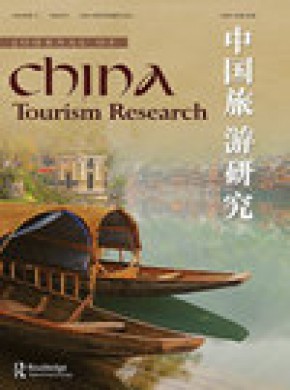
Gold OA文章占比:3.01%
研究類文章占比:100.00%
國際標(biāo)準(zhǔn)簡稱:J CHINA TOUR RES
人氣 187
《Journal Of China Tourism Research》是一本English學(xué)術(shù)期刊,由Taylor & Francis出版商出版,旨在及時、準(zhǔn)確、全面地報道國內(nèi)外在該領(lǐng)域的科學(xué)研究等工作中取得的經(jīng)驗(yàn)、科研成果、技術(shù)革新、學(xué)術(shù)動態(tài)等。該刊已被SCIE、ESCI數(shù)據(jù)庫收錄,2023年影響因子為1.3。
The Journal of China Tourism Research is an international academic journal dedicated to the study of Chinese tourism, founded by the School of Hotel and Tourism Management at The Hong Kong Polytechnic University in 2005. This magazine is published quarterly and has been continuously distributed for many years. It is committed to publishing high-quality research articles on the Greater China Cultural Circle and the tourism issues of overseas Chinese. JCTR's articles usually cover the hotel industry, service quality, destination image, Chinese Mainland, rural tourism, market segmentation and other tourism related fields.
The magazine has become the official journal of the International Federation of Tourism Research in China. Although it has not yet been included in the Social Science Citation Index (SSCI), it has been included in the Extended Social Science Citation Index (ESSCI). The journal has a stable submission volume, receiving over 150 articles annually and having a relatively high acceptance rate. Compared to other mainstream journals in the tourism industry, it provides more flexible submission opportunities. It is not only a platform for tourism scholars to publish research results, but also an important resource for industry professionals to obtain cutting-edge research and theoretical insights. The magazine promotes international exchange and academic dialogue in Chinese tourism research by publishing various forms of papers such as empirical research, theoretical exploration, review articles, and case studies. In addition, the magazine emphasizes cross linguistic collaborative research, encouraging researchers from different language backgrounds to explore complex issues in the field of tourism together, thereby promoting the diverse development of the global tourism academic community.
| 按JIF指標(biāo)學(xué)科分區(qū) | 收錄子集 | 分區(qū) | 排名 | 百分位 |
| 學(xué)科:HOSPITALITY, LEISURE, SPORT & TOURISM | ESCI | Q3 | 90 / 139 |
35.6%
|
| 按JCI指標(biāo)學(xué)科分區(qū) | 收錄子集 | 分區(qū) | 排名 | 百分位 |
| 學(xué)科:HOSPITALITY, LEISURE, SPORT & TOURISM | ESCI | Q3 | 75 / 139 |
46.4%
|
JCR分區(qū):JCR(Journal Citation Reports)由科睿唯安公司(前身為湯森路透)開發(fā)。JCR沒有設(shè)置大類,只將期刊分為176個具體學(xué)科,也就是中科院分區(qū)中的小類學(xué)科。基于不同學(xué)科的當(dāng)年影響因子高低進(jìn)行排序,將期刊的數(shù)量均勻分為四個部分,Q1區(qū)代表學(xué)科分類中影響因子排名前25%的期刊,以此類推,Q2區(qū)為前25%-50%期刊,Q3區(qū)為前50%-75%期刊,Q4區(qū)為75%以后期刊。
CiteScore排名:
| 學(xué)科類別 | 分區(qū) | 排名 | 百分位 |
| 大類:Social Sciences 小類:Cultural Studies | Q1 | 62 / 1304 |
95%
|
| 大類:Social Sciences 小類:Language and Linguistics | Q1 | 83 / 1088 |
92%
|
| 大類:Social Sciences 小類:Linguistics and Language | Q1 | 99 / 1167 |
91%
|
| 大類:Social Sciences 小類:Tourism, Leisure and Hospitality Management | Q2 | 70 / 146 |
52%
|
CiteScore值計算方式:例如2024公布的CiteScore是將統(tǒng)計在 2020年-2023年間年所發(fā)表文章的引用次數(shù)除以在 2020年-2023年間所發(fā)表的發(fā)文總數(shù)。
CiteScore數(shù)據(jù)來源:是由全球著名學(xué)術(shù)出版商Elsevier(愛思唯爾)基于其Scopus數(shù)據(jù)庫推出的期刊評價指標(biāo)。CiteScore指數(shù)以四年區(qū)間為基準(zhǔn)來計算每本期刊的平均被引用次數(shù),并提供期刊領(lǐng)域排名、期刊分區(qū)的相關(guān)信息,它的作用是測量期刊的篇均影響力。
近年IF值(影響因子)趨勢圖
影響因子:是美國科學(xué)信息研究所(ISI)的期刊引證報告(JCR)中的一項(xiàng)數(shù)據(jù)。指的是某一期刊的文章在特定年份或時期被引用的頻率,是衡量學(xué)術(shù)期刊影響力的一個重要指標(biāo)。自1975年以來,每年定期發(fā)布于“期刊引證報告”(JCR)。
1、建議稿件控制10頁以上,文章撰寫語言為英語;(單欄格式,單倍行距,內(nèi)容10號字體,文稿類型包含:原創(chuàng)研究(Original Research)、案例報告(Case Report)、文獻(xiàn)綜述(Literature Review)等;文件格式包含word、PDF、LaTeX等。
2、稿件重復(fù)率控制10%以內(nèi),論文務(wù)必保證原創(chuàng)性、圖標(biāo)、公式、引文等要素齊備,保證附屬資料的完整。已發(fā)表或引用過度的文章將不會被出版和檢索,禁止一稿多投,拒絕抄襲、機(jī)械性的稿件。
3、稿件必須有較好的英語表達(dá)水平,有圖,有表,有公式,有數(shù)據(jù)或設(shè)計,有算法(方案,模型),實(shí)驗(yàn),仿真等;參考文獻(xiàn)控制25條以上,參考文獻(xiàn)引用一半以上控制在近5年以內(nèi)。
圖片和圖表要求:1、建議使用TIFF、EPS、JPEG格式 ,TIFF格式 使用LZW壓縮。
2、文件大小最大不超過20MB,不要以單個文件的形式上傳數(shù)據(jù)。
3、彩色圖片的分辨率≥300dpi;黑白圖片的分辨率在≥500dpi;line art圖片類型的分辨率≥1000dpi;色彩模式建議采用RGB,除非期刊注明要CMYK。
4、線條不要細(xì)于0.25pt,也不能太粗,超過1.5pt,過細(xì)或過粗都影響美觀。
5、表格一般和manuscrript放置在一個word文檔里部分期刊 需要單獨(dú)上傳表格。
作者信息:1、包括作者姓名、最高學(xué)位,作者單位(精確到部門),郵箱,地址,郵編,關(guān)鍵詞,內(nèi)容,總結(jié),項(xiàng)目基金,參考文獻(xiàn),作者相片+簡介(一定要確保作者信息準(zhǔn)確無誤,提交稿件之后這部分不能再作改動)。
更多征稿細(xì)則請查閱雜志社征稿要求。本站專注期刊咨詢服務(wù)十年,確保SCI檢索,稿件信息安全保密,合乎學(xué)術(shù)規(guī)范不成功不收費(fèi),詳情請咨詢客服。
若用戶需要出版服務(wù),請聯(lián)系出版商。